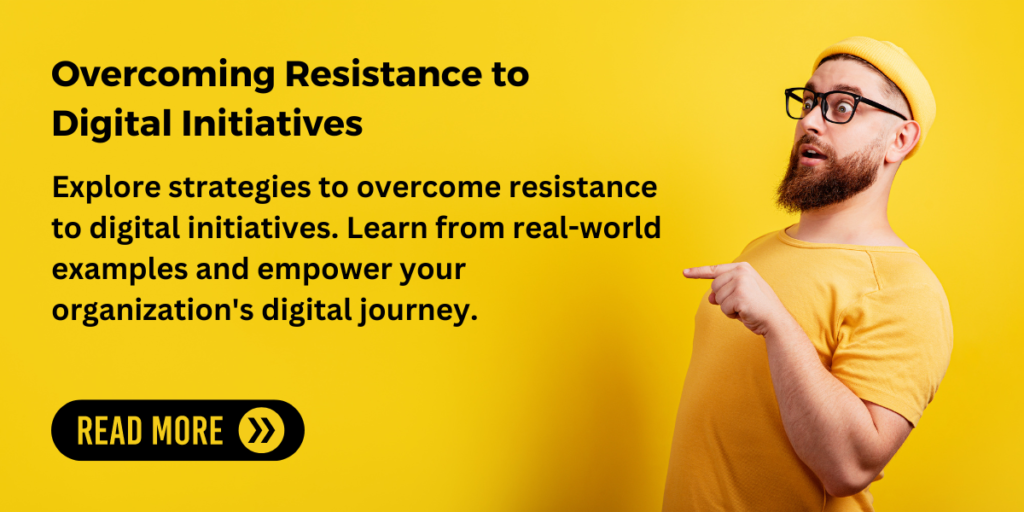Hello there, digital pioneers!
Let’s dive into a topic that’s been buzzing around the corporate world like a bee around a blossoming flower – building a company culture that supports digital initiatives. Now, you might be wondering, “What’s all the fuss about company culture and digital initiatives?” Well, as it turns out, it’s a pretty big deal, and here’s why.
In our fast-paced, tech-driven world, digital initiatives are no longer just a ‘nice-to-have’ – they’re a ‘must-have’. We’re talking about things like digital transformation, digital literacy, and fostering a growth mindset. These aren’t just fancy buzzwords; they’re crucial elements that can make or break a company’s success in the digital age.
In my previous article, we explored strategies to overcome resistance to digital initiatives and learned interesting stuff from real-world examples. Now, it´s time to build a culture that supports it.
So, What Are We Talking About?
Before we go any further, let’s make sure we’re all on the same page about what these terms mean:
Digital Initiatives: These are efforts undertaken by a company to leverage digital technologies to improve their business. It could be anything from implementing a new CRM system, to automating manual processes, to using AI for customer service.
Digital Literacy: This is the ability to use, understand, and interact with technology effectively. In a workplace context, it means that employees are comfortable using digital tools and platforms that are necessary for their jobs.
Growth Mindset: Coined by psychologist Carol Dweck, this term refers to the belief that abilities and intelligence can be developed through dedication and hard work. In a digital context, it means being open to learning new technologies, adapting to change, and seeing challenges as opportunities for growth.
Now that we’ve got the definitions down, let’s explore why a company culture that supports these elements is so important, and how you can build one. Buckle up, because we’re about to embark on a digital culture journey!
Embracing the Digital-First Culture
Alright, let’s get down to business. Why is a digital-first culture so important? Well, in the simplest terms, it’s because we’re living in a digital world. Whether we’re ordering food, booking a vacation, or running a multinational corporation, digital technology plays a massive role. So, it only makes sense that our workplaces reflect this digital reality.
The Role of Company Culture in Digital Transformation
First things first, let’s talk about digital transformation. This is the process of using digital technologies to create new or modify existing business processes, culture, and customer experiences to meet changing business and market requirements. Sounds pretty important, right? It is! But here’s the kicker – a successful digital transformation isn’t just about the technology. It’s about the people and the culture.
According to an article on Entrepreneur, company culture plays a crucial role in digital transformation. It’s the glue that holds everything together. Without a culture that supports and embraces digital initiatives, all the technology in the world won’t make a difference.
Data-Driven Culture: The New Norm
Now, let’s talk about being data-driven. In today’s world, data is king. It’s the fuel that powers decision-making and strategy in successful businesses. But again, having a bunch of data is one thing – knowing what to do with it is another. That’s where a data-driven culture comes in.
The Harvard Business Review highlights that a whopping 63% of chief executives don’t believe their companies make good use of their analytics. That’s a big deal! A data-driven culture encourages employees at all levels to use data in their decision-making processes, leading to more informed, effective decisions.
Key Elements of a Culture that Supports Digital Initiatives
We’ve established the importance of a digital-first culture; let’s dive into the nitty-gritty. What are the key elements that make up a culture that supports digital initiatives? Let’s break it down.
Promoting Digital Literacy
First on the list is digital literacy. In a world where technology is a part of our everyday lives, being digitally literate is no longer optional – it’s a necessity. But what does it mean to be digitally literate?
Digital literacy is all about having the skills and knowledge to use digital technologies effectively. It’s about being comfortable navigating the digital world, whether that’s using a new software tool at work or figuring out the latest social media platform.
But here’s the thing – promoting digital literacy isn’t just about providing training on specific tools. It’s about fostering a culture where learning and adapting to new technologies is encouraged and supported. It’s about making sure that everyone, from the intern to the CEO, is equipped with the skills they need to thrive in the digital age.
Fostering a Growth Mindset
Next up is the growth mindset. This is a concept that was developed by psychologist Carol Dweck, and it’s all about the belief that our abilities and intelligence can be developed through dedication and hard work.
In the context of digital initiatives, a growth mindset is crucial. Why? Because the digital world is constantly evolving. What’s cutting-edge today might be outdated tomorrow. So, we need to be able to adapt and grow with it.
Fostering a growth mindset in your company culture means encouraging employees to see challenges as opportunities for learning and growth rather than obstacles. It means rewarding effort and progress, not just results. And it means creating an environment where mistakes are seen as a natural part of the learning process, not something to be feared or punished.
Encouraging Innovation
Last but definitely not least, we have innovation. Now, I know what you’re thinking – “Innovation? That’s just a buzzword that every company throws around.” And you’re not wrong. But when we talk about a culture that supports digital initiatives, innovation is a key piece of the puzzle.
According to an article on Entrepreneur, your company needs an innovation culture, not just an innovation team. What does that mean? It means that innovation shouldn’t be siloed in one team or department. Instead, it should be a part of the company culture as a whole. Everyone should be encouraged to think creatively, to question the status quo, and to come up with new ideas.
Case Studies
We’ve talked a lot about the theory behind building a culture that supports digital initiatives. But what does this look like in practice? Let’s take a look at some real-world examples of companies that are nailing it.
Google: Building on Workplace Commitments
Tech giant Google. Now, you might be thinking, “Of course, Google has a digital-first culture. They’re a tech company!” And you’re not wrong. But it’s not just about the industry they’re in – it’s about the commitments they’ve made to their workplace culture.
In a blog post, Google outlined their commitment to fostering a culture that supports digital initiatives. They’ve taken a hard line on inappropriate conduct, worked to provide better support for those who report it, and made significant progress in making their culture more inclusive. This commitment to a positive workplace culture is a key part of their success in the digital world.
Hyatt: Fostering a Culture of Technology Innovation
Hyatt, a global hospitality company. In an article on Business Insider, Hyatt’s CCO, Mark Vondrasek, shared his advice for fostering a culture of tech innovation.
Vondrasek’s approach is all about listening and learning. He believes that business leaders don’t always have all the answers, and that it’s important to loop in constituents and listen to their ideas. This approach to fostering a culture of innovation has helped Hyatt thrive in the digital age.
Strategies for Building a Digital-Ready Culture
We’ve talked about the why and the what. Now, let’s get to the how. How can you build a digital-ready culture in your own organization? Let’s dive into some strategies that can help you on your journey.
Strategy 1: Accelerate Digital Transformation
You need to accelerate your digital transformation. This might sound daunting, but don’t worry – it’s not about making huge changes overnight. It’s about taking consistent, strategic steps toward becoming more digital.
According to an article on Entrepreneur, there are a few key ways to do this:
- Invest in the right technology: This might seem obvious, but it’s worth repeating. The right technology can make all the difference in your digital transformation efforts.
- Train your team: Remember what we said about digital literacy? It’s crucial. Make sure your team has the skills they need to use your digital tools effectively.
- Stay agile: The digital world is constantly changing, and you need to be able to change with it. Stay flexible, stay agile, and be ready to adapt.
Strategy 2: Foster a Data-Driven Culture
It’s time to get serious about data. As we mentioned earlier, being data-driven is a game-changer. But how do you foster a data-driven culture?
Here are a few tips:
- Make data accessible: If you want your team to use data in their decision-making, they need to be able to access it. Invest in tools that make data easy to access and understand.
- Encourage data literacy: Just like digital literacy, data literacy is a must. Provide training to help your team understand how to interpret and use data.
- Celebrate data-driven decisions: When someone uses data to make a decision, celebrate it. This will help to reinforce the importance of data in your company culture.
Strategy 3: Encourage Innovation
It’s time to let your creative juices flow. Innovation is a key part of a culture that supports digital initiatives, and it’s something that should be encouraged at all levels of your organization.
Here are a few ways to foster innovation:
- Create a safe space for ideas: People are more likely to share their ideas if they feel safe doing so. Create an environment where all ideas are welcomed and valued.
- Reward innovation: Whether it’s through recognition, rewards, or simply a shout-out in a team meeting, make sure to celebrate innovation.
- Promote collaboration: Innovation rarely happens in a vacuum. Encourage your team to collaborate, share ideas, and learn from each other.
Conclusion
Well, folks, we’ve been on quite a journey. We’ve explored the ins and outs of building a culture that supports digital initiatives, from understanding the importance of a digital-first culture to diving into the key elements and strategies for building one. But as with any journey, it’s not just about the destination – it’s about what we’ve learned along the way.
The Digital Culture Recap
Let’s take a moment to recap:
- Digital initiatives are crucial in today’s fast-paced, tech-driven world. They’re the key to staying competitive and thriving in the digital age.
- Company culture plays a vital role in supporting these initiatives. It’s the glue that holds everything together, from promoting digital literacy to fostering a growth mindset and encouraging innovation.
- Building a digital-ready culture is a journey, not a destination. It requires commitment, effort, and a willingness to adapt and grow.
The Next Steps
So, where do we go from here? Well, that’s up to you. Every company is unique, with its own culture, challenges, and opportunities. But no matter where you’re starting from, there’s always room to grow and improve.
Take a moment to assess your current culture. Where are you excelling, and where could you improve? Are you promoting digital literacy, fostering a growth mindset, and encouraging innovation? Are you making data-driven decisions and investing in the right technology?
Remember, building a digital-ready culture isn’t about making huge changes overnight. It’s about taking consistent, strategic steps towards becoming more digital. And with the strategies we’ve discussed, you have the tools you need to start making those changes.
So, here’s to your digital journey. It might be challenging, it might be complex, but it’s also an exciting opportunity to grow, innovate, and thrive in the digital age. You’ve got this!


